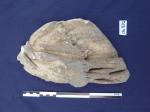
Description
- 872
- Fragmentary bust of a cuirassed male
- 2nd to early 3rd c. AD
- White marble.
- 33 cm tall, 18 cm wide, 4.7 cm thick at inner, right side; approximately 9 cm thick max. on the left side.
- Condition: broken at right, the lower end preserves intact the finished edge of the lower bust, and the top and left-hand curve of the shoulder and upper arm. Much cloak is preserved, as are portions of the left shoulder and upper arm leather strap epaulets of the missing cuirass. One new break flaked away a big scar at the end of the innermost portion of the dangling cloak swag, along whose left contour the ancient right-side break runs. Stained, with light grey encrustation overall, and weathered and lightly chipped surfaces.
- This is a fragment of the fringed military mantle (paludamentum) draping the left-most portion of a marble cuirassed bust portrait. The fringed mantle swag is depicted as dangling down the draped chest, pulled around the back from the lost right shoulder where the cloak was pinned and over the left shoulder. The break follows the line where the marble bust-plate thinned on the right edge of the thickened mass of the swag. The swag presents as a fan of three principal stacked pleats; these overlay the body of the mantle, which is rendered as several drapery flutes and flattened folds.
- The fringed swag is found on portraits of rulers in military guise from the Antonine and Severan dynasties. It was especially common for images of Lucius Verus, but also appears on extant portraits of Marcus Aurelius, Septimius Severus, and Clodius Albinus. The style of thick, plastically modeled folds that curl to make a pattern of flaps over the textile’s pleats fits a period esthetic, as do the chiaroscuro effects of the fringe’s drilled texture against the smoother surfaces.nThe piece comes from the top of the road leading to the villa, in front of the slave barracks which were constructed in the early 3rd c., and which were not destroyed until the 7th c.. This would not have been the bust’s original context in the villa, however. Like the fragment of a leg of a life-sized statue, which emerged from the same context, it must have decorated a luxury quarter of the villa.
- Bust of Hadrian in the British Museum from Hadrian’s villa at Tivoli (British Museum GR 1805,0703.95, British Museum online at Highlights, http://www.britishmuseum.org/explore/highlights/highlight_objects/gr/m/marble_bust_of_hadrian.aspx, Arachne Object 10818. - Antoninus Pius, fringed cloak, British Museum GR 1861.11-27.14, from Cyrene (House of Jason Magnus), British Museum database sv Pius Jason marble, Arachne Object 10519, Wegner, 1939, 132 and 1979, 106, Fittschen 1999, 115 cat. 22. - Lucius Verus, fringed cloak: British Museum, Arachne Object 10831, Wegner 1939, 233, Wegner 1980, 48; Modena, Arachne Object 38509, Wegner 1939, 235, Wegner 1980 49. - Commodus, slightly fringed cloak, Munich, Arachne Object 12568, Wegner 1939, 259 and Wegner 1980, 85 - Munich Glyptothek Septimius Severus, Wünsche 2007, 146 and fig. **, see also Arachne Object 12570. - Severus, and his associate Albinus, Louvre 1120, fringed cloak, McCann 1968, pl. 166, cat. 91b, http://cartelfr.louvre.fr/cartelfr/visite?srv=car_not_frame&idNotice=2881&langue=fr. - Antonine busts with fringed cloak, two private portraits of young and of mature man at Castle Howard, Fejfer 2008, 313-14, fig. 234-5 (youth); Fittschen 1999, 90, cat. 76, pl. 162 (youth), Borg et al. 2005, 191-4 cat. 45 pl. 47 (youth, Arachne Object 3793) and 85 cat. 41 pl. 40-41 (man, Arachne Object 3794). Generally to Verus and Marcus images, Albertson 1979, Wegner 1939 and Wegner 1979 and Wegner 1980, Fittschen 1999, and to the floruit of the fringed paludamentum bust type, Fittschen and Zanker 1983, 76-7 cat. 69 pl. 79, 2010 117-18 cat. 118 pl. 117-18.
Record Details
-
VM_5267
- strato di distruzione entro ambiente 25-28, allargamento W 2009















![Download [view]](/villamagna/ark//skins/villamagna/images/results/download_sml.png)
